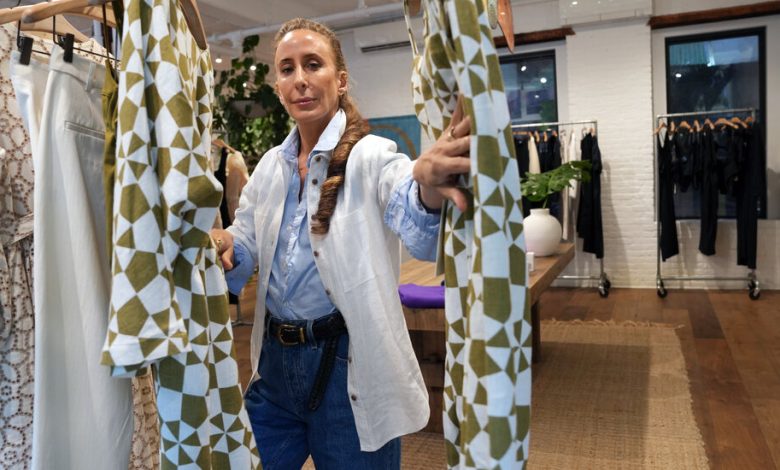She Burned It All Down, to Build the Perfect Dress

It looked like a normal dress, a nice one. Something you might wear to a wedding if you wanted to be a bit sexy. It was floor-length, the V-neck plunging into a rosette that swirled and gathered under the bust, and the spaghetti straps crisscrossed on a low-cut back, kind of like a sporty, 1970s swimsuit.
It’s the kind of dress Mara Hoffman, who has been in business for 23 years, could whip up without a second thought. But this particular version has been five years in the making.
“Feel this,” Ms. Hoffman said at her Lafayette Street store in Manhattan one September morning as she held out the coral-colored fabric. It had the texture of peach skin. “If you go through the store and feel through all of our product, nothing really feels like this.”
The story behind the dress is not sexy — or maybe it is, depending on what you’re into. One of an edition of 35 currently for sale at $1,195, the dress is woven from a proprietary fabric made by a Virginia company called Circ, which has patented technology to separate and recycle poly-cotton blends — meaning one part is polyester and one part is cotton — into fibers that can be respun into fabric.
This is a big deal in the world of fabric recycling because, up until now, it has been extremely difficult to break down and recycle blended fabrics, like your old T-shirts, stretch jeans and leggings. “Roughly half of all fabric produced is poly-cotton,” said Peter Majeranowski, the chief executive of Circ.
Circ sources fabric from a few places: factories and mills, which supply shirts that were damaged along the supply chain; charities with an excess of donated clothes; and partners like Patagonia that have a take-back program, in which old clothes are repaired and resold. If those clothes can’t be resold, they go to a warehouse until a solution like Circ comes along.
Ms. Hoffman’s dresses represent what both companies are billing as the first time Circ lyocell fabric is being used for a luxury product, as an alternative to silk, which she has eliminated from her offerings.
“I was longing for the feeling of silk,” Ms. Hoffman said. “It’s always been, how do we speak to this luxury that we really can’t get through our cottons and hemps, the materials that we had safe and vetted access to? What’s our alternative to black tie that isn’t a harmful garment?” In the next three years, Ms. Hoffman has committed to replacing all of the virgin lyocell in her collections with Circ’s recycled version.
Ms. Hoffman first encountered Circ in 2018, when Dana Davis, her vice president of sustainability, product and business strategy, attended the Global Fashion Agenda Summit in Copenhagen. Ms. Davis recalled that Circ’s original technology was developed for tobacco farms that were no longer supplying cigarette manufacturers. She was intrigued.
“We came from the biofuels industry,” Mr. Majeranowski said. “We knew nothing about fashion, and they’ve been patient with us.”
For Ms. Hoffman, the Dress that Changes Everything, as she has christened the style made with Circ, is another chapter in the radical repositioning of her brand that began in 2015. Until then, Mara Hoffman had been the go-to purveyor of sexy psychedelic prints and bikinis for the Coachella crowd. Hers was a robust business that began in 2000 when, as a recent Parsons graduate, she showed up at stores, including Patricia Field in New York, with a bag of clothes she made in her Murray Hill apartment. Her collection was originally called Circle.
“I did a strip show, tried everything on and they placed their first order,” Ms. Hoffman said.
As time wore on, Mara Hoffman the brand felt increasingly disconnected from Mara Hoffman the woman, on a spiritual and aesthetic level. The birth of her son led her to look at the future of the planet differently. “The True Cost,” a 2015 documentary that examined the ravages of fast fashion, shook her. She was disgusted by the overproduction and toxicity that coursed through the industry.
“I couldn’t design what I was designing anymore,” she said.
At one point Ms. Hoffman found herself crying on her couch, telling Ms. Davis that she wanted to close the business. Instead, they committed to an absolute overhaul, shifting from widely distributed hippie prints to more serene and sophisticated collection — still sexy — with serious sustainability commitments. In the process, they lost half of their retail partners.
“Burn it to the ground,” Ms. Hoffman said. “That’s sort of my style. It’s not for the faint of heart.”
Changing the look of the brand was relatively easy. “I can design something new tomorrow and transform. I’m good at that,” Ms. Hoffman said. More challenging was getting all of her back-of-house sustainable dreams to live up to what the customer was used to. It’s been a process of trial and error, baby steps.
A first order of business was switching to organic and recycled materials whenever feasible. But that is not always possible. “We started working with a system that is still considered a Band-Aid for us, taking plastic bottles, turning them into polyester for our swimwear,” Ms. Davis said. The problem is that once a plastic bottle is turned into swimwear, it’s difficult to recycle from there. Now Ms. Hoffman uses Pyratex, a fabric made out of wood pulp with no polyester or nylon, for swimwear.
Ms. Hoffman introduced compostable packaging, but no one knew how to compost it, so the company switched to paper, which people are used to recycling. She started Full Circle, the company’s take-back and resale program. She designed extended sizes that went beyond a basic black dress. The stretchy, sexy Popcorn dress — available in a range of colors and silhouettes and in sizes XXS to 3X — was released in 2020 and continues to be a hit.
“It was a swim line before — now it’s a fashion brand,” said Rachael Wang, a former editor and stylist who started working with Ms. Hoffman to shift the visual identity of the brand in 2015. “I think creating a more splashy, fashion-y brand that has this intentionality was exactly what people wanted to see, what people wanted to buy into.”
Ms. Hoffman has run her business independently with no outside investment. But she hasn’t done it alone. Ms. Davis has been with her for 15 years, and they oversee a staff of 25. There’s also the broader sustainability community, of which they are vocal and active members. The Mara Hoffman website is encyclopedic in its indexing of partners, policies and supply-chain transparency.
Ms. Hoffman was early to fashion’s awakening to the overproduction and climate crises, but she doesn’t consider herself a pioneer. “There were a handful of brands that we were able to see as beacons,” she said, naming Eileen Fisher, Stella McCartney and Patagonia. “They were doing something better.”
Nonetheless, the Circ dresses represent impact, a real change to a system. Next month, Ms. Hoffman will receive the Environmental Sustainability Award from the Council of Fashion Designers of America.
“I think we’ve figured out some really important parts that have longevity, so let’s push into that,” Ms. Hoffman said.



